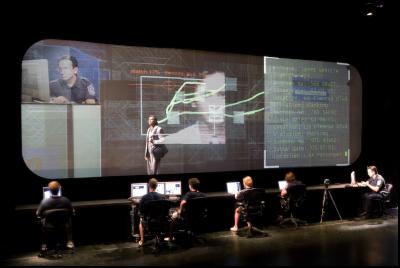Arts Festival Review: Super Vision
Super Vision
Reviewed by Lyndon Hood
Click for big version
Super Vision
The Builders
Association & dbox
1 - 5 March
8:30pm (70
minutes)
The Events Centre, Wellington
The first
thing that happens in Super Vision makes it
abundantly clear that They have been watching You. And if
the sight of an actor presenting the audience with its own
consumer profile doesn't give you pause for thought, the
Privacy Commission's helpful ad on the back of the programme
provides a long list of organisations that probably have
your personal information just by virtue of your being alive
- without even mentioning the last website you
visited.
Super Vision tells three stories, episodes from each coming in turn, each exploring a different aspect of personal information and personal identity in the present day, and one's own and others' access to both.
The form is perfectly matched to this content. The main playing space is through a round-edged frame like an giant, ultra-wide monitor, faced by a bank of computers. Inside this space the actors move through scenes and images projected from in front and behind onto moving transparent screens.
The Builders Association are know for their multimedia work and here, with design studio dbox, they have created a magnificent showcase for multimedia theatre. The skill and experience required to make and operate it smoothly - running and creating video and graphics live, making these interact with actors, incorporating live elements - are deeply impressive. The video, sound (also excellent) and action have clearly been integrated through the whole evolution of the project.
The versatility of the setup is used to great effect, in giving each storyline its own tone and visual style.
Each story also makes some use of the possibility of projecting the actor's faces at large scale live, providing intense, movie-like close-ups - typical of this production that continually blurs the lines between play and live film. In the eye of a digital storm, the acting and movement that works best is in the internal 'film' style rather than the typically 'theatrical'.
A woman in New York video-chats with her grandmother in India. She is transforming the old woman's photographs and documents into a digital archive, as a matter of course: "so you'll never lose them". Even as she is doing this, her grandmother's actual personality and memory begin to collapse.
A father (played by New Zealand writer/director Harry Sinclair) uses his son's identity, developed into an adult, in a web of credit fraud. Obsessively tending his virtual child, he neglects his wife and his 'real' son ("John Jr" is, in fact, a video projection).
In this storyline, the visual setting and images reflect the situation in the 'data' world well: the sequence when, under imminent threat of discovery, the father decides to disappear from the information sphere is particularly strong. But it's frustrating that, in the midst of all this technology, the company couldn't find any way to actually reveal the situation and the feelings of the characters than expository soliloquies. It's a fascinating irony that the only story that puts two actors actually in the same physical space has the least convincing characters and interactions.
It was also here, in a couple of moments, that they may have tried to push their setup too far. It appears it's not feasible to physically interact - to use or play with - objects projected onto a video screen in a visually convincing way. Perhaps they shouldn't have tried.
The most compelling story - in terms of dramatic situation, and of character, and of the themes of the production - was that of the traveller. As an African businessman makes repeated entries through US customs, the information gathers - past movements, credit card spending, legal records, health records, fingerprints, photos and eye scans; everything is available to the man in the blue uniform and gradually the net grows.
Thanks to the technology of the performance, we can literally see as the traveller becomes the physical apex of an expanding pyramid of data. The tension of the immediate question - will they let him in? - mixes with the increasingly surreal levels of their knowledge and increasing security checks to feed his reactions to a series of not-quite-identical customs officials.
After one unsuccessful attempt to fight, he finally learns to love his "data body". He takes care of it, it takes care of him. And it engulfs him.
The festival has already had at one remarkable multimedia piece - Eraritjaritjaka - and promises more, but Super Vision (co-produced by the festival) will surely it's greatest technical tour de force. It uses modern technology to visualise and explore a most modern and technological subject.
I'm not burning my cedit card just yet, but in an age where data collection and matching and profiling and sales are constantly exapanding, it's important to take a look at where we stand.
Super Vision is that look.
NZ Arts Festival: Super Vision
Super Vision
website
The Builders Association website
dbox
website
Scoop
Audio Interview: Super Vision director Marianne
Weems
Scoop
Full Coverage: Festival
2006


 Binoy Kampmark: Condemning The Right To Self-Defence - Iran’s Retaliation And Israel’s Privilege
Binoy Kampmark: Condemning The Right To Self-Defence - Iran’s Retaliation And Israel’s Privilege Gordon Campbell: On The Making Of King Donald
Gordon Campbell: On The Making Of King Donald Binoy Kampmark: Rogue States And Thought Crimes - Israel Strikes Iran
Binoy Kampmark: Rogue States And Thought Crimes - Israel Strikes Iran Eugene Doyle: The West’s War On Iran
Eugene Doyle: The West’s War On Iran Richard S. Ehrlich: Deadly Border Feud Between Thailand & Cambodia
Richard S. Ehrlich: Deadly Border Feud Between Thailand & Cambodia Gordon Campbell: On Free Speech And Anti-Semitism
Gordon Campbell: On Free Speech And Anti-Semitism